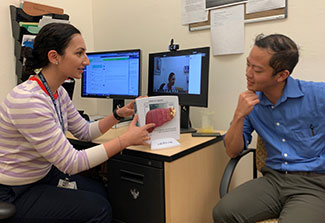Profile: Fogarty Scholar Dr. Nauzley Abedini studies neonatal jaundice in Ghana
March / April 2020 | Volume 19, Number 2

Photo courtesy of Dr. Nauzley Abedini
As a Fogarty Scholar working in Ghana, Dr. Nauzley Abedini
estimated the prevalence of neonatal jaundice and evaluated
the ability of mothers to recognize signs of the disease in
their babies.
By Susan Scutti
Dr. Nauzley Abedini understood from her own research that medical students from Ghana who train in the U.S. find patient-centered care unusual. When she herself trained in Ghana as a
Fogarty Scholar, Abedini experienced the difference in medical cultures firsthand: “Patient-focused communication is not a common practice there.”
Then a third-year University of Michigan medical student, Abedini hoped to gain field knowledge of a country that she’d studied from a distance. Primarily, though, she wished to improve her research skills by conducting mixed-method research of infant jaundice.
Globally, neonatal jaundice - a complication of prematurity, birth-related injuries and other illnesses - is a large problem. “In sub-Saharan Africa, infant jaundice is one of the top five leading causes of infant mortality and the leading cause of neurological problems in infants,” explained Abedini. This is due, in part, to a high rate of an enzyme deficiency, which is thought to be an evolutionary phenomenon to protect against malaria.
To estimate the prevalence of infant jaundice in Ghana, Abedini first conducted a review by examining nearly 1,000 admissions at a district hospital in Kumasi over a 16-month period. Jaundice was the second most prevalent diagnosis of babies in the neonatal ICU - 30% had the condition.
Next, Abedini designed a questionnaire for mothers with jaundiced babies as a method for understanding risk factors. For example, in Ghana, moms believe camphor - which is in mothballs - helps keep a baby clean while protecting the child’s health. Abedini suspected the practice of placing camphor inside infant clothing might be contributing to high rates of jaundice. Yet, her survey showed that less than 10% of the mothers used camphor in their baby’s clothing.
One in five of the 235 total respondents had no knowledge of infant jaundice, while three in four were misinformed. “Even though their babies had jaundice, they didn’t know what it was,” said Abedini. And a quarter of mothers with jaundiced babies waited more than 24 hours to bring their children to the hospital.
As part of her fellowship, Abedini received on-the-job biostatistics training. Analyzing the data she’d collected, she identified a significant “upstream” problem. “Moms did not recognize the signs of jaundice: a baby with yellow skin and eyes, a baby not feeding well, a baby who is lethargic or floppy or running a fever.” This suggested to Abedini that before researchers tried to devise solutions to diminish jaundice in Ghana, they needed to address maternal education first. As a result of her work, subsequent studies began to focus on communicating health instructions to moms.
Before arriving in Africa, Abedini had wondered, “How do you ensure your work does not unintentionally cause harm?” Her Ghana mentors taught her that the consent process - exceedingly difficult when working with a range of languages and literacy levels - prevents researchers from taking advantage of those who may not be able to advocate for themselves. Collaborative work in Ghana taught Abedini that conducting research in a developing country comes with challenges that cannot be anticipated without firsthand experience. She was encouraged that the tools developed for her study have been disseminated for use in other countries.
Seeing the degree of suffering in Africa led Abedini to change her focus to global palliative care research. She is now a palliative care clinical fellow at the University of California, San Francisco and will soon complete her clinical training. She continues to rely on her Fogarty mentors as she builds collaborations with global organizations and chairs a palliative care working group of the Consortium of Universities for Global Health (CUGH).
Her Fogarty fellowship was a life-changing experience, Abedini said. “What I learned through Fogarty informs everything I do today.”
More Information
To view Adobe PDF files,
download current, free accessible plug-ins from Adobe's website.